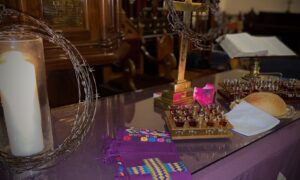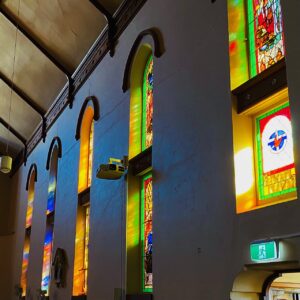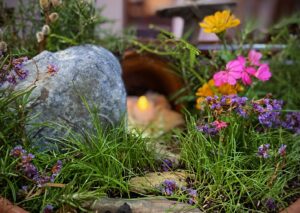I grew up in the west country of England, first in Devon, and then Somerset, the county I still consider home. I have memories from early childhood of me and my three siblings squeezed into the back of mum’s car and driving around Dartmoor. We’d all sing songs and hymns in the car as we drove around, and one sticks in my mind: J Wilbur Chapman’s “One day” with its well-known chorus:
Living, He loved me; dying, He saved me,
Buried, He carried my sins far away,
Rising He justified, freely forever:
One day He’s coming – O glorious day.
Wilbur Chapman, evangelist in life, and whose words are still communicating the Gospel message a hundred years after his death.
In the days leading up to the Easter weekend, the church was lit up in purple. Not because of Lent – though we were still in Lent – but in support of Epilepsy Awareness. Shining brightly on the spire, and clearly visible against the purple backdrop, was the cross – a signpost to passing traffic of the great act of love and sacrifice at the heart of the Easter message. Clayton Wesley’s spire has been telling folks to “look up and live” for 170 years.
There is no doubt that as a community, we have very consciously stepped into the Easter narratives this year. The invitation came on Palm Sunday when we listened to “Who is He in yonder stall?” – the verses of Hanby’s hymn urging us to consider the scenes of Jesus’ life, and to ask ourselves, “who is Jesus to me?”
Together we journeyed from the anticipation of Palm Sunday – “we had hoped that He was the One…” – to the contemplation of the Last Supper, through the shock and dread of Gethsemane when Judas and the soldiers came with weapons, to the agony of Calvary, the subsequent fear and grieving, and then the joy of Easter Sunday, just as Jesus had promised “but I will see you again.” The Gospel meets us in the highs and lows of our lives, speaks of solidarity with us* and brings us life and hope.
The Gospel invitation has been there at the heart of every homily this Easter, reinforced through the words of our singing and the solos. We listened to Yvonne sing Wesley’s “Behold Him, all ye that pass by, the bleeding Prince of life and peace!” and couldn’t help but imagine Calvary. Listening to Millicent and Rick sing “I love You Lord, and I lift my voice…” we couldn’t help but place ourselves into the Easter story – this isn’t anybody’s history, but rather our history, our God, working to bring us home.
The altar changed from purple to black to white. But even in the starkness of the Good Friday altar, I could see the sun shine brightly through the northern windows giving a rainbow of colour – a sign of promise in the economy of the cross. On Easter Day, the church was filled with butterflies – symbols of hope and new life. And we even ran out of Communion glasses on Sunday which, God willing, points to new growth among us.
In sharing Holy Communion, in our silences, in our prayerful petitions and candle lighting, in the Scripture readings and poetry and children’s talk, in our giving, and in our welcoming of visitors, we have all participated in Easter worship as a community. I have felt very keenly that we were worshiping as family together in this place.
My wish is that our Easter recollections this year will continue to speak to each of us, and to sustain us. When I return in May, I will be in my second year as the minister at Clayton Wesley. Over the last 12 months, I have preached the Gospel 40 times. Long may that continue. And may God do great things in and through us this coming year.
On Palm Sunday, Hanby’s hymn asked us, “Who is He…?” The chorus answers:
“‘Tis the Lord! O wondrous story! Tis the Lord, the King of Glory!
At His feet we humbly fall. Crown Him, crown Him Lord of all!”



Scripture references from – Num 21:8, Jn 3:14b-16, Lk 24:21, Jn 18:3, Jn 16:22.
*John Stott, in “The cross of Christ”
“One Day” is by J Wilbur Chapman, 1910.
“Who is He in Yonder Stall” is by Benjamin Russell Hanby, 1866.
“O Love Divine, what hast Thou done?” is by Charles Wesley, 1742.


